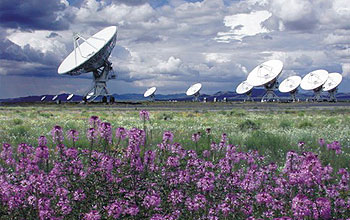|

All Images

Discovery
New Mexico Graduate Student Receives Costa Rica's Top Science Honor

Back to article | Note about images
 |
Esteban Araya is the youngest person ever to be awarded Costa Rica's prestigious Clodomiro Picado Twight National Award in Science. Here, he stands in front of the Very Large Array in Socorro, New Mexico.
Credit: E. Araya, New Mexico Institute of Mining and Technology |
Download the high-resolution JPG version of the image. (393 KB)
|
Use your mouse to right-click (Mac users may need to Ctrl-click) the link above and choose the option that will save the file or target to your computer.
|
 |
The Very Large Array (VLA) telescope, operated by the National Radio Astronomy Observatory (NRAO), is located on the Plains of San Agustin, about 50 miles (80 kilometers) west of the Array Operations Center in Socorro, New Mexico. The VLA is composed of 27 individual antennas arranged in a "Y" pattern. Four times each year, the VLA antennas are arranged in new configurations by a transporter that moves along dual sets of railroad tracks. In the antennas' closest configuration, about 0.6 miles (1 kilometer) wide, the VLA is able to image large portions of the sky. In its largest configuration, about 22 miles (36 kilometers) wide, the VLA is able to hone in on the fine details of astronomical objects.
Credit: NRAO/AUI and photographer Kelly Gatlin; digital composite, Patricia Smiley |
Download the high-resolution JPG version of the image. (69 KB)
|
Use your mouse to right-click (Mac users may need to Ctrl-click) the link above and choose the option that will save the file or target to your computer.
|
 |
As the site of the world's largest single-dish radio telescope, the Arecibo Observatory in Puerto Rico is one of the largest centers for research in radio astronomy, planetary radar and terrestrial aeronomy. Every year about 200 scientists visit the observatory. The huge "dish" is 1000 feet (305 meters) in diameter, 167 feet (51 meters) deep and covers an area of about twenty acres (0.08 square kilometers).
Credit: NAIC Arecibo Observatory, a facility of the NSF |
Download the high-resolution JPG version of the image. (900 KB)
|
Use your mouse to right-click (Mac users may need to Ctrl-click) the link above and choose the option that will save the file or target to your computer.
|
 |
The Green Bank Telescope (GBT), located in Green Bank, West Virginia, is the world's largest, fully steerable radio telescope. At 485 feet (148 meters), the GBT stands taller than the Statue of Liberty. The telescope's surface--composed of more than 2,000 metal panels--covers almost two acres (about 8,000 square meters). Thanks to an innovative design that maximizes the dish's useful surface area and minimizes reflections, the GBT can be pointed with an accuracy equivalent to the width of a single human hair seen from six feet (two meters) away.
Credit: National Radio Astronomy Observatory/Associated Universities, Inc. |
|






